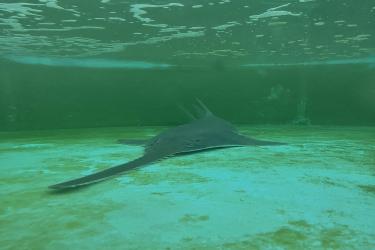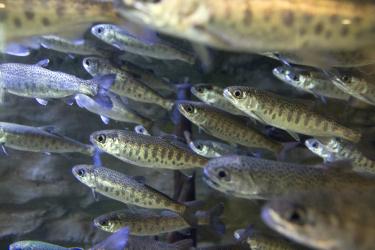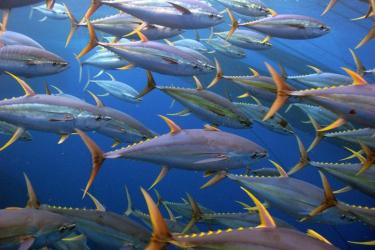KEY MESSAGE:
NOAA Fisheries requests your comments on the proposed rule for Regulatory Amendment 29 to the Fishery Management Plan for the Snapper-Grouper Fishery of the South Atlantic Region, which if implemented, would modify gear requirements for the fishery. Comments are due by May 6, 2020.
SUMMARY OF PROPOSED CHANGES:
- require descending devices be on board and readily available for use on commercial, for-hire, and private recreational vessels while fishing for or possessing snapper-grouper species;
- require the use of non-offset, non-stainless steel circle hooks when fishing for snapper-grouper species with hook-and-line gear and natural baits north of 28º north latitude;
- require all hooks be non-stainless steel when fishing for snapper-grouper species with hook-and-line gear and natural baits south of 28º north latitude; and
- allow the use of powerheads in federal waters off South Carolina.
HOW TO COMMENT ON THE PROPOSED RULE:
You may submit comments by electronic submission or by postal mail. Comments sent by any other method (such as e-mail), to any other address or individual, or received after the end of the comment period, may not be considered by NOAA Fisheries.
FORMAL FEDERAL REGISTER NUMBER: 85 FR 22118, April 21, 2020
Electronic Submissions: Submit all electronic public comments via the Federal e-Rulemaking Portal.
1. Go to https://www.regulations.gov/docket?D=NOAA-NMFS-2020-0008.
2. Click the "Comment Now!" icon, complete the required fields.
3. Enter or attach your comments.
Mail: Submit written comments to Frank Helies, Southeast Regional Office, NMFS, 263 13th Avenue South, St. Petersburg, FL 33701.
FREQUENTLY ASKED QUESTIONS (FAQs)
Why are changes to snapper-grouper fishing gear being considered?
- Commercial and recreational fishermen have expressed concern about regulations that result in released fish that do not survive.
- Some released fish die due to foul hooking (hooking the fish in the stomach or throat), injuries caused by barotrauma (injury due to expansion of gas when reeled up from depth), handling damage, stress from the fishing process, and predation.
- To improve the survivorship of released fish, the South Atlantic Fishery Management Council considered measures that would encourage the use of best fishing practices that aim to minimize the impact of capture.
- Fishermen have also expressed concern regarding inequitable access for the dive component of the snapper-grouper fishery. To allow for more consistent regulations, the proposed rule would remove the powerhead prohibition in federal waters off South Carolina.
What would constitute an allowable descending device?
- Descending device means an instrument to which is attached a minimum of a 16 ounce weight and a length of line that will release the fish at the depth from which the fish was caught or a minimum of 60 feet.
- The descending device attaches to the fish’s mouth or is a container that will hold the fish. The device MUST be capable of releasing the fish automatically, by the actions of the operator of the device, or by allowing the fish to escape on its own.
- Since minimizing surface time is critical to increasing survival, descending devices shall be readily available for use while engaged in fishing.
- Examples of descending devices that meet the requirements can be found in Regulatory Amendment 29 and the table below.
When and how should descending devices be used?
- It is the intent of the South Atlantic Fishery Management Council that descending devices only be used when a fish may be experiencing barotrauma (e.g., caught in deep water, protruding stomach, etc.).
- This proposed rule would not prohibit the use of venting tools for those individuals that know how to use them properly (e.g., trained crew on charter vessels or headboats).
|
|
Readily Available for Use |
Video Instructions |
Examples |
|
Weighted Hooks |
Attached to an easily accessible, separate rod and reel or handline capable of reeling up a sizable lead with weight sufficient to descend targeted fish. |
|
|
|
Lip Clamp Devices |
Attached to an easily accessible, separate rod and reel or handline capable of reeling up a sizable lead with weight sufficient to descend targeted fish. |
|
|
|
Box Type Devices |
Attached to length of rope sufficient to descend fish to a minimum of 50 feet or, ideally, the depth of capture. |
|
|
|
|
|
|
|
|
Venting Devices |
N/A |
|
What new hook requirements are being proposed?
- Currently, non-stainless steel circle hooks are required to be used when fishing for snapper-grouper species with hook-and-line gear and natural baits north of 28º north latitude, which is a line running east to west approximately 25 miles south of Cape Canaveral, Florida.
- This proposed rule would require the use of non-offset, non-stainless steel circle hooks when fishing for snapper-grouper species with hook-and-line gear and natural baits north of 28º north latitude. Non-offset circle hooks can reduce the occurrence of hooking-related mortality (when compared to offset circle hooks and J-hooks) and can improve survivorship of released fish.
- This proposed rule would also require the use of non-stainless steel hooks when fishing for snapper-grouper species with hook-and-line gear and natural baits south of 28º north latitude. All hooks, regardless of type, would need to be constructed of non-stainless steel. Non-stainless steel hooks degrade faster than stainless steel hooks, so fish that are released with an embedded hook would likely have a greater chance of survival through their use.
What are powerheads and why did the South Atlantic Fishery Management Council request lifting the prohibition on powerhead use off South Carolina?
- Powerheads, also known as bang-sticks, are any device with an explosive charge, usually attached to a spear gun, spear, pole, or stick, that fires a projectile upon contact.
- Currently, powerheads may not be used to harvest snapper-grouper species in federal waters off South Carolina but are allowed in federal waters off North Carolina, Georgia, and Florida.
- To allow for more consistent regulations for the dive component of the fishery, the proposed rule would remove the powerhead prohibition in federal waters off South Carolina.
Where can I find more information on best fishing practices?
- The South Atlantic Fishery Management Council intends to conduct a substantial education and outreach effort to ensure fishermen participating in the snapper-grouper fishery understand the new regulations and how to properly use descending devices.
- Regulatory Amendment 29 also contains a Research and Monitoring Plan for Descending Devices (Appendix E).
- The South Atlantic Fishery Management Council developed a best fishing practices tutorial
Where can I find more information on Regulatory Amendment 29?
- Regulatory Amendment 29 may be found online at the NOAA Fisheries Southeast Regional Office Website
- By Mail: Frank Helies
NOAA Fisheries, Southeast Regional Office
Sustainable Fisheries Division
263 13th Avenue South
St. Petersburg, Florida 33701-5505
By FAX: (727) 824-5308
By Phone: (727) 824-5305
SIGN UP FOR TEXT MESSAGE ALERTS - FIND OUT ABOUT IMMEDIATE OPENINGS AND CLOSURES
NOAA's Text Message Alert Program allows you to receive important fishery related alerts via text message (SMS). Standard message & data rates may apply. You may opt-out at any time.
Text alerts you may receive include:
- Immediate fishery openings and closures
- Any significant changes to fishing regulations that happen quickly
Sign up for one or more of the following groups:
- Gulf of Mexico Recreational Fisheries Related Alerts
- Text GULFRECFISH to 888777
- Gulf of Mexico Commercial Fisheries Related Alerts
- Text GULFCOMMFISH to 888777
- South Atlantic Recreational Fisheries Related Alerts
- Text SATLRECFISH to 888777
- South Atlantic Commercial Fisheries Related Alerts
- Text SATLCOMMFISH to 888777
- Caribbean Fisheries Related Alerts
- Text CARIBFISH to 888777
![]() Join us every other Friday on NOAA Fish Instagram for Rec Fish Friday!
Join us every other Friday on NOAA Fish Instagram for Rec Fish Friday!
Other contacts:
Media: Kim Amendola, 727-551-5707
Allison Garrett, 727-551-5750


